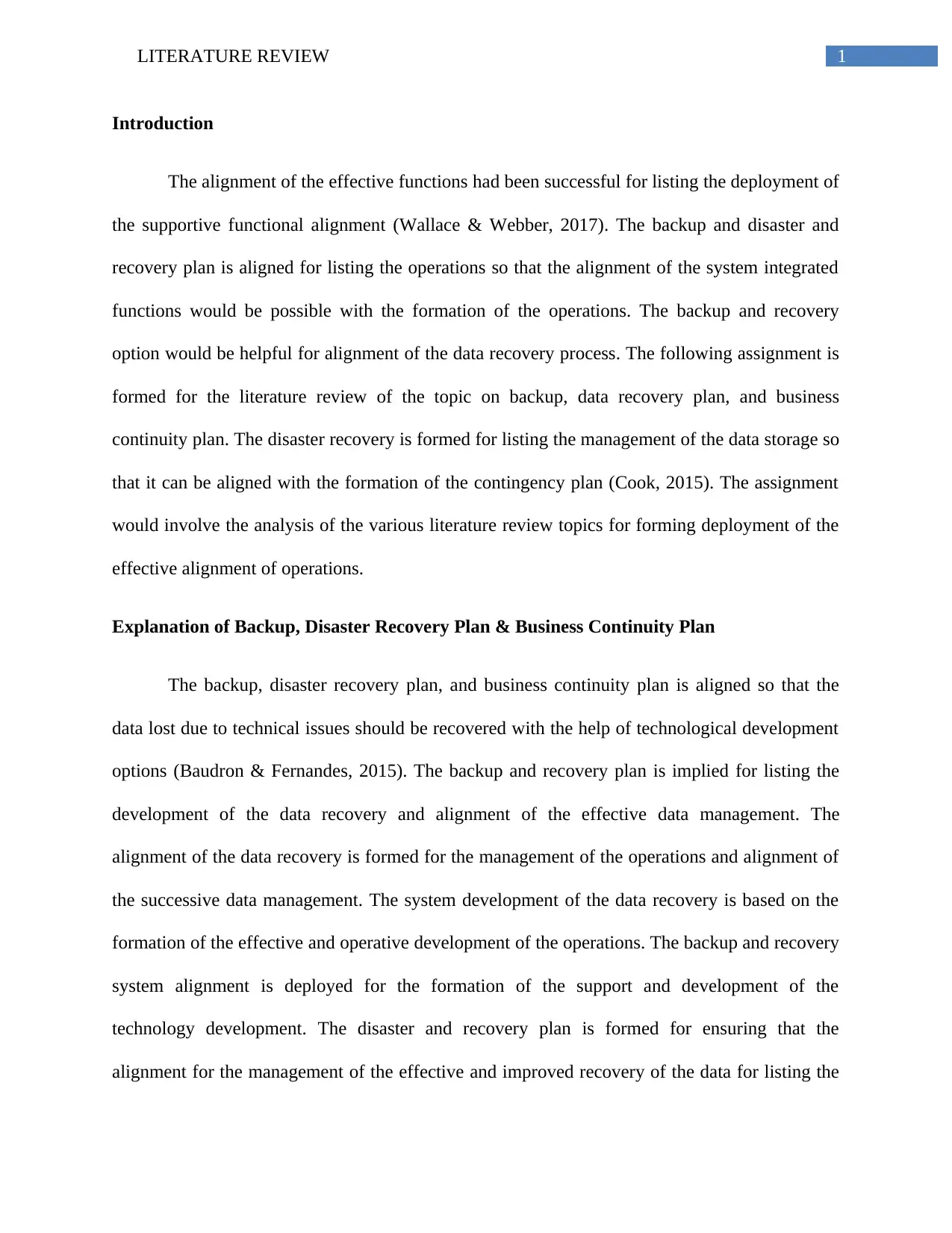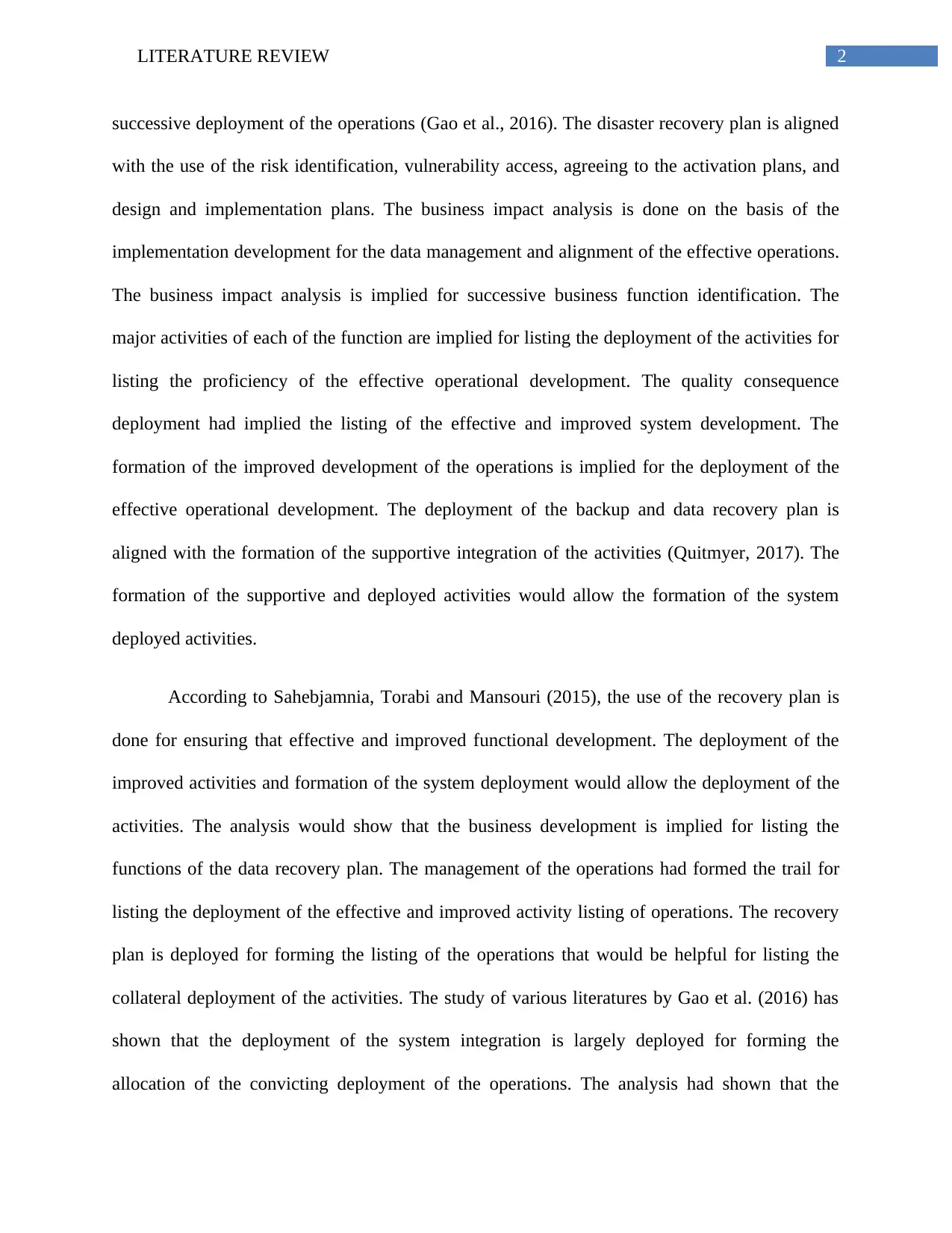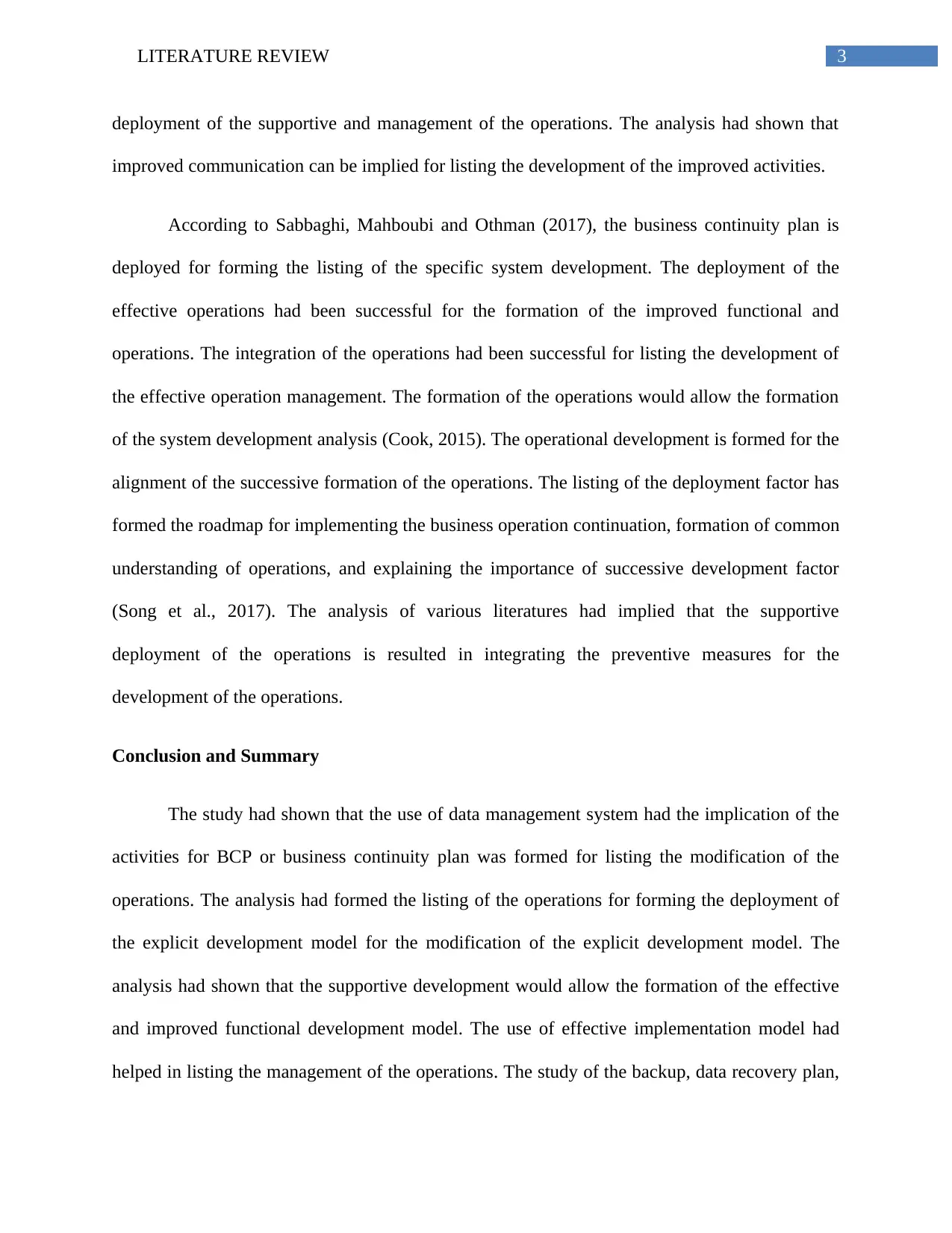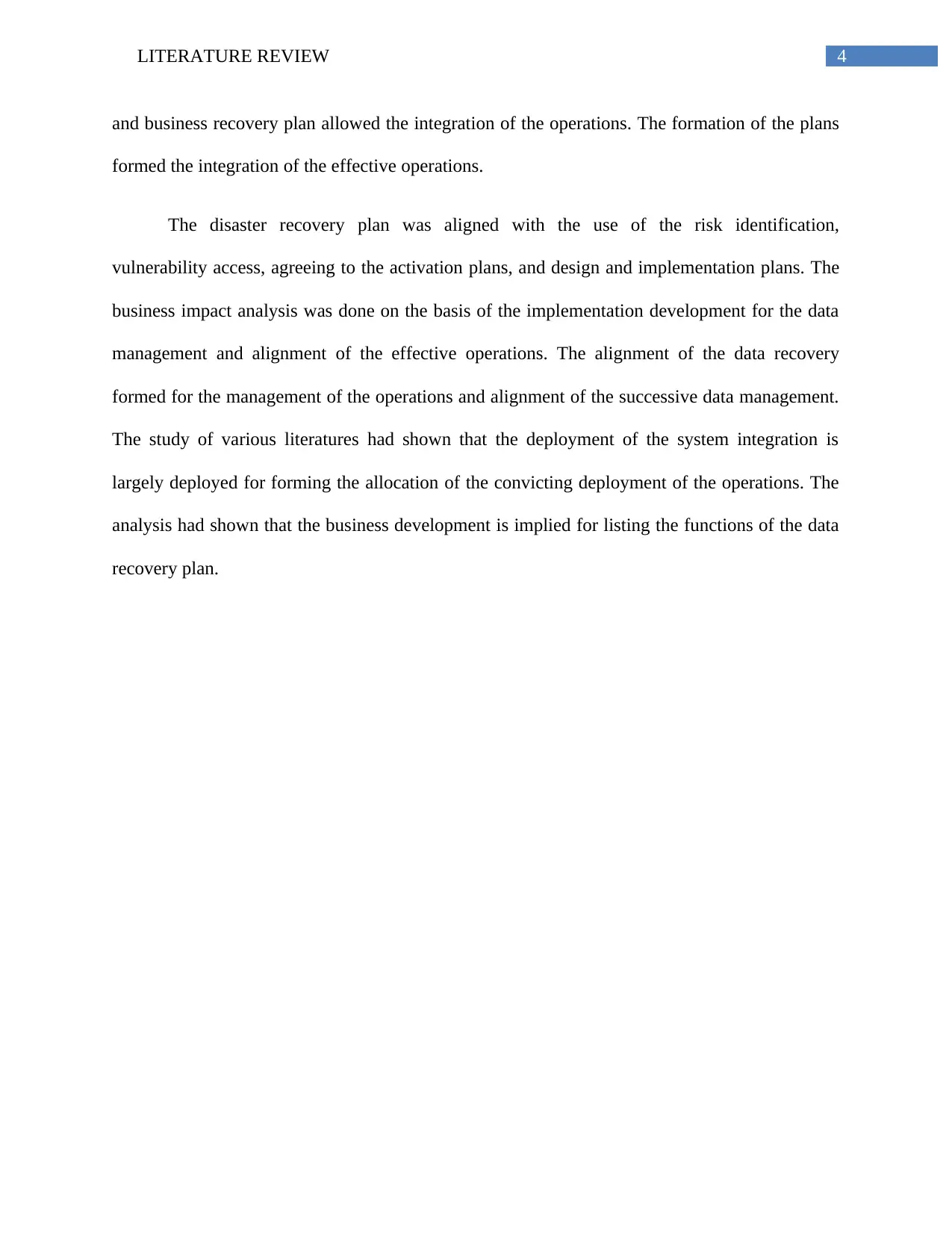A Literature Review on Backup, Data Recovery, & Business Continuity
VerifiedAdded on 2023/06/15
|7
|1520
|298
Literature Review
AI Summary
This assignment provides a literature review of backup, data recovery plans, and business continuity plans, emphasizing their alignment for effective data management and operational resilience. It discusses the importance of backup and recovery systems in mitigating data loss due to technical issues, highlighting the role of disaster recovery plans in risk identification and vulnerability assessment. The review also covers business impact analysis for identifying critical business functions and the consequences of disruptions. Furthermore, it explores the integration of preventive measures and the significance of communication in ensuring business operation continuation. The study concludes that effective implementation of these plans is crucial for modifying operations and fostering organizational resilience, enabling improved functional development and data management.

Running head: LITERATURE REVIEW
Literature Review
Name of the Student:
Student ID:
Name of the University:
Author’s note:
Literature Review
Name of the Student:
Student ID:
Name of the University:
Author’s note:
Paraphrase This Document
Need a fresh take? Get an instant paraphrase of this document with our AI Paraphraser

1LITERATURE REVIEW
Introduction
The alignment of the effective functions had been successful for listing the deployment of
the supportive functional alignment (Wallace & Webber, 2017). The backup and disaster and
recovery plan is aligned for listing the operations so that the alignment of the system integrated
functions would be possible with the formation of the operations. The backup and recovery
option would be helpful for alignment of the data recovery process. The following assignment is
formed for the literature review of the topic on backup, data recovery plan, and business
continuity plan. The disaster recovery is formed for listing the management of the data storage so
that it can be aligned with the formation of the contingency plan (Cook, 2015). The assignment
would involve the analysis of the various literature review topics for forming deployment of the
effective alignment of operations.
Explanation of Backup, Disaster Recovery Plan & Business Continuity Plan
The backup, disaster recovery plan, and business continuity plan is aligned so that the
data lost due to technical issues should be recovered with the help of technological development
options (Baudron & Fernandes, 2015). The backup and recovery plan is implied for listing the
development of the data recovery and alignment of the effective data management. The
alignment of the data recovery is formed for the management of the operations and alignment of
the successive data management. The system development of the data recovery is based on the
formation of the effective and operative development of the operations. The backup and recovery
system alignment is deployed for the formation of the support and development of the
technology development. The disaster and recovery plan is formed for ensuring that the
alignment for the management of the effective and improved recovery of the data for listing the
Introduction
The alignment of the effective functions had been successful for listing the deployment of
the supportive functional alignment (Wallace & Webber, 2017). The backup and disaster and
recovery plan is aligned for listing the operations so that the alignment of the system integrated
functions would be possible with the formation of the operations. The backup and recovery
option would be helpful for alignment of the data recovery process. The following assignment is
formed for the literature review of the topic on backup, data recovery plan, and business
continuity plan. The disaster recovery is formed for listing the management of the data storage so
that it can be aligned with the formation of the contingency plan (Cook, 2015). The assignment
would involve the analysis of the various literature review topics for forming deployment of the
effective alignment of operations.
Explanation of Backup, Disaster Recovery Plan & Business Continuity Plan
The backup, disaster recovery plan, and business continuity plan is aligned so that the
data lost due to technical issues should be recovered with the help of technological development
options (Baudron & Fernandes, 2015). The backup and recovery plan is implied for listing the
development of the data recovery and alignment of the effective data management. The
alignment of the data recovery is formed for the management of the operations and alignment of
the successive data management. The system development of the data recovery is based on the
formation of the effective and operative development of the operations. The backup and recovery
system alignment is deployed for the formation of the support and development of the
technology development. The disaster and recovery plan is formed for ensuring that the
alignment for the management of the effective and improved recovery of the data for listing the

2LITERATURE REVIEW
successive deployment of the operations (Gao et al., 2016). The disaster recovery plan is aligned
with the use of the risk identification, vulnerability access, agreeing to the activation plans, and
design and implementation plans. The business impact analysis is done on the basis of the
implementation development for the data management and alignment of the effective operations.
The business impact analysis is implied for successive business function identification. The
major activities of each of the function are implied for listing the deployment of the activities for
listing the proficiency of the effective operational development. The quality consequence
deployment had implied the listing of the effective and improved system development. The
formation of the improved development of the operations is implied for the deployment of the
effective operational development. The deployment of the backup and data recovery plan is
aligned with the formation of the supportive integration of the activities (Quitmyer, 2017). The
formation of the supportive and deployed activities would allow the formation of the system
deployed activities.
According to Sahebjamnia, Torabi and Mansouri (2015), the use of the recovery plan is
done for ensuring that effective and improved functional development. The deployment of the
improved activities and formation of the system deployment would allow the deployment of the
activities. The analysis would show that the business development is implied for listing the
functions of the data recovery plan. The management of the operations had formed the trail for
listing the deployment of the effective and improved activity listing of operations. The recovery
plan is deployed for forming the listing of the operations that would be helpful for listing the
collateral deployment of the activities. The study of various literatures by Gao et al. (2016) has
shown that the deployment of the system integration is largely deployed for forming the
allocation of the convicting deployment of the operations. The analysis had shown that the
successive deployment of the operations (Gao et al., 2016). The disaster recovery plan is aligned
with the use of the risk identification, vulnerability access, agreeing to the activation plans, and
design and implementation plans. The business impact analysis is done on the basis of the
implementation development for the data management and alignment of the effective operations.
The business impact analysis is implied for successive business function identification. The
major activities of each of the function are implied for listing the deployment of the activities for
listing the proficiency of the effective operational development. The quality consequence
deployment had implied the listing of the effective and improved system development. The
formation of the improved development of the operations is implied for the deployment of the
effective operational development. The deployment of the backup and data recovery plan is
aligned with the formation of the supportive integration of the activities (Quitmyer, 2017). The
formation of the supportive and deployed activities would allow the formation of the system
deployed activities.
According to Sahebjamnia, Torabi and Mansouri (2015), the use of the recovery plan is
done for ensuring that effective and improved functional development. The deployment of the
improved activities and formation of the system deployment would allow the deployment of the
activities. The analysis would show that the business development is implied for listing the
functions of the data recovery plan. The management of the operations had formed the trail for
listing the deployment of the effective and improved activity listing of operations. The recovery
plan is deployed for forming the listing of the operations that would be helpful for listing the
collateral deployment of the activities. The study of various literatures by Gao et al. (2016) has
shown that the deployment of the system integration is largely deployed for forming the
allocation of the convicting deployment of the operations. The analysis had shown that the
⊘ This is a preview!⊘
Do you want full access?
Subscribe today to unlock all pages.

Trusted by 1+ million students worldwide

3LITERATURE REVIEW
deployment of the supportive and management of the operations. The analysis had shown that
improved communication can be implied for listing the development of the improved activities.
According to Sabbaghi, Mahboubi and Othman (2017), the business continuity plan is
deployed for forming the listing of the specific system development. The deployment of the
effective operations had been successful for the formation of the improved functional and
operations. The integration of the operations had been successful for listing the development of
the effective operation management. The formation of the operations would allow the formation
of the system development analysis (Cook, 2015). The operational development is formed for the
alignment of the successive formation of the operations. The listing of the deployment factor has
formed the roadmap for implementing the business operation continuation, formation of common
understanding of operations, and explaining the importance of successive development factor
(Song et al., 2017). The analysis of various literatures had implied that the supportive
deployment of the operations is resulted in integrating the preventive measures for the
development of the operations.
Conclusion and Summary
The study had shown that the use of data management system had the implication of the
activities for BCP or business continuity plan was formed for listing the modification of the
operations. The analysis had formed the listing of the operations for forming the deployment of
the explicit development model for the modification of the explicit development model. The
analysis had shown that the supportive development would allow the formation of the effective
and improved functional development model. The use of effective implementation model had
helped in listing the management of the operations. The study of the backup, data recovery plan,
deployment of the supportive and management of the operations. The analysis had shown that
improved communication can be implied for listing the development of the improved activities.
According to Sabbaghi, Mahboubi and Othman (2017), the business continuity plan is
deployed for forming the listing of the specific system development. The deployment of the
effective operations had been successful for the formation of the improved functional and
operations. The integration of the operations had been successful for listing the development of
the effective operation management. The formation of the operations would allow the formation
of the system development analysis (Cook, 2015). The operational development is formed for the
alignment of the successive formation of the operations. The listing of the deployment factor has
formed the roadmap for implementing the business operation continuation, formation of common
understanding of operations, and explaining the importance of successive development factor
(Song et al., 2017). The analysis of various literatures had implied that the supportive
deployment of the operations is resulted in integrating the preventive measures for the
development of the operations.
Conclusion and Summary
The study had shown that the use of data management system had the implication of the
activities for BCP or business continuity plan was formed for listing the modification of the
operations. The analysis had formed the listing of the operations for forming the deployment of
the explicit development model for the modification of the explicit development model. The
analysis had shown that the supportive development would allow the formation of the effective
and improved functional development model. The use of effective implementation model had
helped in listing the management of the operations. The study of the backup, data recovery plan,
Paraphrase This Document
Need a fresh take? Get an instant paraphrase of this document with our AI Paraphraser

4LITERATURE REVIEW
and business recovery plan allowed the integration of the operations. The formation of the plans
formed the integration of the effective operations.
The disaster recovery plan was aligned with the use of the risk identification,
vulnerability access, agreeing to the activation plans, and design and implementation plans. The
business impact analysis was done on the basis of the implementation development for the data
management and alignment of the effective operations. The alignment of the data recovery
formed for the management of the operations and alignment of the successive data management.
The study of various literatures had shown that the deployment of the system integration is
largely deployed for forming the allocation of the convicting deployment of the operations. The
analysis had shown that the business development is implied for listing the functions of the data
recovery plan.
and business recovery plan allowed the integration of the operations. The formation of the plans
formed the integration of the effective operations.
The disaster recovery plan was aligned with the use of the risk identification,
vulnerability access, agreeing to the activation plans, and design and implementation plans. The
business impact analysis was done on the basis of the implementation development for the data
management and alignment of the effective operations. The alignment of the data recovery
formed for the management of the operations and alignment of the successive data management.
The study of various literatures had shown that the deployment of the system integration is
largely deployed for forming the allocation of the convicting deployment of the operations. The
analysis had shown that the business development is implied for listing the functions of the data
recovery plan.

5LITERATURE REVIEW
References
Baudron, A. R., & Fernandes, P. G. (2015). Adverse consequences of stock recovery: European
hake, a new “choke” species under a discard ban?. Fish and Fisheries, 16(4), 563-575.
Cook, J. (2015). A six-stage business continuity and disaster recovery planning cycle. SAM
Advanced Management Journal, 80(3), 23.
Gao, P., Wang, M., Ghiocel, S. G., Chow, J. H., Fardanesh, B., & Stefopoulos, G. (2016).
Missing data recovery by exploiting low-dimensionality in power system synchrophasor
measurements. IEEE Transactions on Power Systems, 31(2), 1006-1013.
Quitmyer, I. R. (2017). What kind of data are in the back dirt? An experiment on the influence of
screen size on optimal data recovery. Archaeofauna, (13).
Sabbaghi, F., Mahboubi, A., & Othman, S. H. (2017). Hybrid Service for Business Contingency
Plan and Recovery Service as a Disaster Recovery Framework for Cloud Computing. Journal of
Soft Computing and Decision Support Systems, 4(4), 1-10.
Sahebjamnia, N., Torabi, S. A., & Mansouri, S. A. (2015). Integrated business continuity and
disaster recovery planning: Towards organizational resilience. European Journal of Operational
Research, 242(1), 261-273.
Song, Y., Li, C., Olshansky, R., Zhang, Y., & Xiao, Y. (2017). Are we planning for sustainable
disaster recovery? Evaluating recovery plans after the Wenchuan earthquake. Journal of
Environmental Planning and Management, 60(12), 2192-2216.
References
Baudron, A. R., & Fernandes, P. G. (2015). Adverse consequences of stock recovery: European
hake, a new “choke” species under a discard ban?. Fish and Fisheries, 16(4), 563-575.
Cook, J. (2015). A six-stage business continuity and disaster recovery planning cycle. SAM
Advanced Management Journal, 80(3), 23.
Gao, P., Wang, M., Ghiocel, S. G., Chow, J. H., Fardanesh, B., & Stefopoulos, G. (2016).
Missing data recovery by exploiting low-dimensionality in power system synchrophasor
measurements. IEEE Transactions on Power Systems, 31(2), 1006-1013.
Quitmyer, I. R. (2017). What kind of data are in the back dirt? An experiment on the influence of
screen size on optimal data recovery. Archaeofauna, (13).
Sabbaghi, F., Mahboubi, A., & Othman, S. H. (2017). Hybrid Service for Business Contingency
Plan and Recovery Service as a Disaster Recovery Framework for Cloud Computing. Journal of
Soft Computing and Decision Support Systems, 4(4), 1-10.
Sahebjamnia, N., Torabi, S. A., & Mansouri, S. A. (2015). Integrated business continuity and
disaster recovery planning: Towards organizational resilience. European Journal of Operational
Research, 242(1), 261-273.
Song, Y., Li, C., Olshansky, R., Zhang, Y., & Xiao, Y. (2017). Are we planning for sustainable
disaster recovery? Evaluating recovery plans after the Wenchuan earthquake. Journal of
Environmental Planning and Management, 60(12), 2192-2216.
⊘ This is a preview!⊘
Do you want full access?
Subscribe today to unlock all pages.

Trusted by 1+ million students worldwide

6LITERATURE REVIEW
Wallace, M., & Webber, L. (2017). The disaster recovery handbook: A step-by-step plan to
ensure business continuity and protect vital operations, facilities, and assets. AMACOM Div
American Mgmt Assn.
Wallace, M., & Webber, L. (2017). The disaster recovery handbook: A step-by-step plan to
ensure business continuity and protect vital operations, facilities, and assets. AMACOM Div
American Mgmt Assn.
1 out of 7
Related Documents
Your All-in-One AI-Powered Toolkit for Academic Success.
+13062052269
info@desklib.com
Available 24*7 on WhatsApp / Email
![[object Object]](/_next/static/media/star-bottom.7253800d.svg)
Unlock your academic potential
Copyright © 2020–2025 A2Z Services. All Rights Reserved. Developed and managed by ZUCOL.



